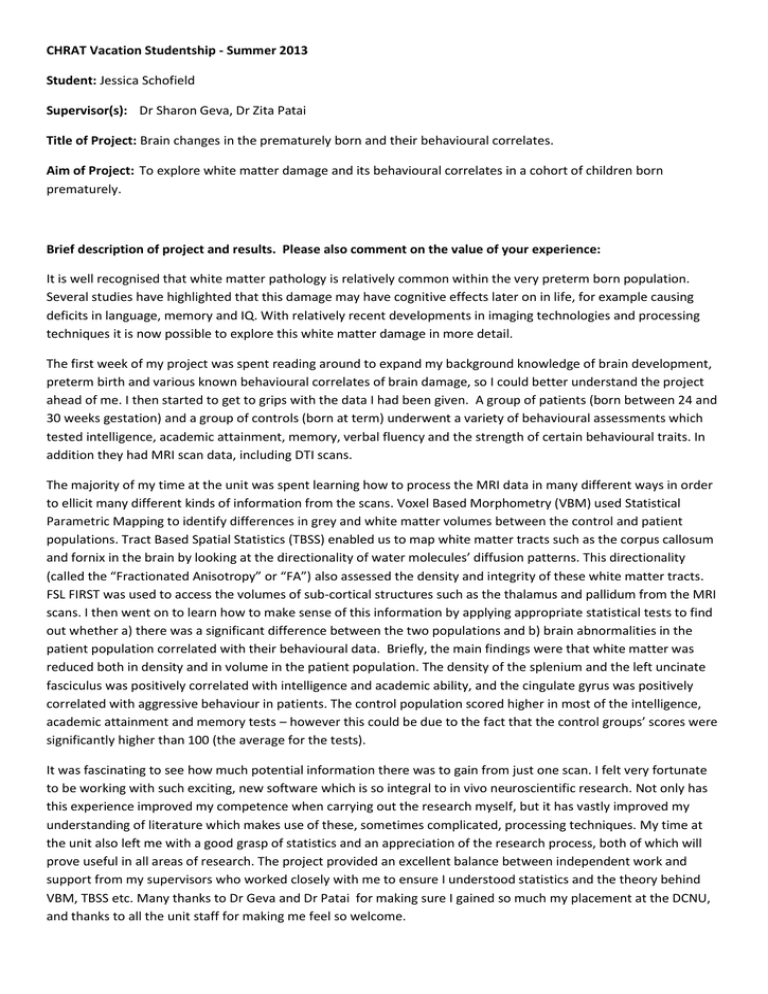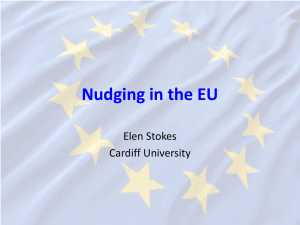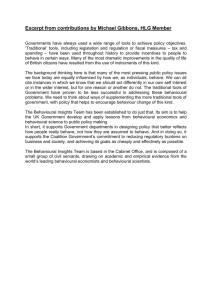CHRAT Vacation Studentship - Summer 2013 Student: Supervisor(s): Title of Project:
advertisement

CHRAT Vacation Studentship - Summer 2013 Student: Jessica Schofield Supervisor(s): Dr Sharon Geva, Dr Zita Patai Title of Project: Brain changes in the prematurely born and their behavioural correlates. Aim of Project: To explore white matter damage and its behavioural correlates in a cohort of children born prematurely. Brief description of project and results. Please also comment on the value of your experience: It is well recognised that white matter pathology is relatively common within the very preterm born population. Several studies have highlighted that this damage may have cognitive effects later on in life, for example causing deficits in language, memory and IQ. With relatively recent developments in imaging technologies and processing techniques it is now possible to explore this white matter damage in more detail. The first week of my project was spent reading around to expand my background knowledge of brain development, preterm birth and various known behavioural correlates of brain damage, so I could better understand the project ahead of me. I then started to get to grips with the data I had been given. A group of patients (born between 24 and 30 weeks gestation) and a group of controls (born at term) underwent a variety of behavioural assessments which tested intelligence, academic attainment, memory, verbal fluency and the strength of certain behavioural traits. In addition they had MRI scan data, including DTI scans. The majority of my time at the unit was spent learning how to process the MRI data in many different ways in order to ellicit many different kinds of information from the scans. Voxel Based Morphometry (VBM) used Statistical Parametric Mapping to identify differences in grey and white matter volumes between the control and patient populations. Tract Based Spatial Statistics (TBSS) enabled us to map white matter tracts such as the corpus callosum and fornix in the brain by looking at the directionality of water molecules’ diffusion patterns. This directionality (called the “Fractionated Anisotropy” or “FA”) also assessed the density and integrity of these white matter tracts. FSL FIRST was used to access the volumes of sub-cortical structures such as the thalamus and pallidum from the MRI scans. I then went on to learn how to make sense of this information by applying appropriate statistical tests to find out whether a) there was a significant difference between the two populations and b) brain abnormalities in the patient population correlated with their behavioural data. Briefly, the main findings were that white matter was reduced both in density and in volume in the patient population. The density of the splenium and the left uncinate fasciculus was positively correlated with intelligence and academic ability, and the cingulate gyrus was positively correlated with aggressive behaviour in patients. The control population scored higher in most of the intelligence, academic attainment and memory tests – however this could be due to the fact that the control groups’ scores were significantly higher than 100 (the average for the tests). It was fascinating to see how much potential information there was to gain from just one scan. I felt very fortunate to be working with such exciting, new software which is so integral to in vivo neuroscientific research. Not only has this experience improved my competence when carrying out the research myself, but it has vastly improved my understanding of literature which makes use of these, sometimes complicated, processing techniques. My time at the unit also left me with a good grasp of statistics and an appreciation of the research process, both of which will prove useful in all areas of research. The project provided an excellent balance between independent work and support from my supervisors who worked closely with me to ensure I understood statistics and the theory behind VBM, TBSS etc. Many thanks to Dr Geva and Dr Patai for making sure I gained so much my placement at the DCNU, and thanks to all the unit staff for making me feel so welcome.



